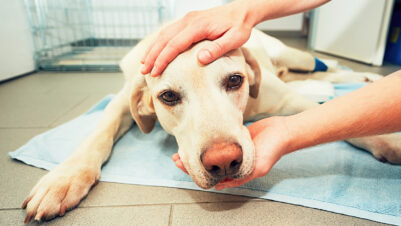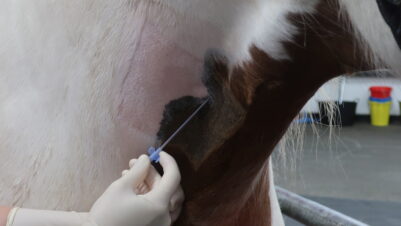Over the last decade, there has been a growing interest in the use of light as a restorative and protective therapy for the treatment of injury and disease in veterinary practice. This is due to numerous factors, including its non-invasive nature and its having no detrimental side effects for the patient or negative environmental impacts. Laser therapy, or photobiomodulation (PBM), has a beneficial effect on cells and tissues, contributing to a directed modulation of cell behaviours and enhancing the processes of tissue repair and cell proliferation while also reducing inflammation and pain.
All these effects make PBM a versatile modality for many “first-aid” situations, such as treating traumatic wounds and burns or acute muscle injuries.
Photobiomodulation – its discovery and how it works
The positive effects of photobiomodulation therapy (formerly called “low-level light therapy” or “LLLT”) were first observed in a rodent model more than 60 years ago by Dr Endre Mester when he noted the effects the application of light had on hair growth and wound healing.
PBM is a photochemical interaction that occurs between the target cells and applied laser light. Mitochondria within the cells contain chromophores that absorb photons from PBM. The primary chromophore of interest is the enzyme cytochrome c oxidase, located in the mitochondrial membrane, which impacts the activity of various molecules, such as nitric oxide (NO), calcium ions, adenosine triphosphate (ATP), beneficial reactive oxygen species (ROS) and numerous other signalling molecules. These molecules work together in various pathways to normalise metabolism and regulate the proteins affected by redox reactions and involved in cellular proliferation and differentiation. Together with cytokines and growth factors, they aid in tissue recovery and the reduction of oxidative stress and inflammation.
Photobiomodulation is a photochemical interaction that occurs between the target cells and applied laser light
In addition to the effects mediated primarily via the biologically active chromophore mentioned above, light-sensitive ion channels are also found in the cell membrane of target cells. These ion channels are gated by light and include “transient receptor potential” (TRP) channels (Freitas de Freitas and Hamblin, 2016) activated by specific factors, such as heat or cold, noxious chemicals, mechanical forces, voltage, etc. When activated, TRP channels open, allowing ions such as sodium to flow into the cell. This results in an action potential realised as a nerve impulse. Mounting evidence suggests that light-mediated activation of TRP is also responsible for some of the action mechanisms of PBM, particularly regarding histamine-dependent wound healing and antinociceptive effects (Freitas de Freitas and Hamblin, 2016).
Photobiomodulation for traumatic wounds, burns and decubital ulcers
The benefits of laser therapy in wound healing are well described in veterinary literature, with in vivo and in vitro studies (Aragão de Melo et al., 2011; Freitas de Freitas and Hamblin, 2016; Mester et al., 1968) showing that PBM:
- Accelerates the activity of fibroblasts, collagen synthesis and neovascularisation
- Decreases inflammatory cells
- Increases the number of elastic fibres in the wound healing process
PBM also offers a demonstrated benefit for thermal burn treatment by encouraging re-epithelialisation and reducing scar tissue (Loreti et al., 2015). It may also have potential benefits for treating infected wounds, where it enhances macrophage function and modulates the immune response (Gal et al., 2006),as well as potentially having some direct effects on microorganisms (MedeirosDe Moraes et al., 2013).
Methodology
Straightforward acute wounds (Figures 1A and 1B) that have been cleaned may only require one to three PBM treatment sessions, depending on the wound size, before significant contraction (Figure 1C) and/or complete healing (Figure 1D) is noted.




Treatment should be administered in an off-contact manner, so you do not further contaminate the wound or the optical probe itself. The entire wound “bed” should be treated, as well as a few inches of healthy-looking tissue in a margin around the wound.
A starting dose of 2 to 5J/cm2 is recommended, treating daily if possible before reducing the frequency of sessions as the lesion improves (Berger et al., 2015). Chronic or infected wounds and thermal burns may require a more aggressive treatment schedule. Alongside other standard-of-care therapies and supportive care measures, higher fluences (energy densities) may be necessary to appreciate beneficial results, especially for wounds such as decubital ulcers. If no improvements are seen after three or four treatment sessions with the previously mentioned starting doses, an increase in the total energy (in total joules) delivered at 25 to 50 percent per session is recommended until a significant response is seen (Bradley, 2017).
It is worth noting that PBM should be applied after the wound or burn has been cleaned (or debrided) and before the application of any dressings, ointments or bandages.
Muscle injuries
PBM may be used preventatively to benefit athletic training by reducing delayed-onset muscle soreness and signs of muscle damage after intense exercise. This modality may also be used to treat muscle damage caused by strains or trauma. Numerous studies have demonstrated the usefulness of PBM in muscle recovery after injury (Bradley, 2017; Ferraresi et al., 2016; Nussbaum et al., 2003). Studies examining markers for oxidative stress and inflammation in the muscle tissue of euthanised animals or serum from other patients demonstrate that PBM accelerated or resolved the acute inflammatory response and reduced oxidative stress elicited by muscle trauma (Borsa et al., 2013; Sussai et al., 2010). Other research looking at the effects of PBM on histopathological features after muscle injury shows that it attenuated the extent of oedema, myofibrillar degeneration and areas of necrosis (De Marchi et al., 2012).
For transcutaneously delivered light to be effective in injured muscle tissue, the light’s parameters and photobiomodulation application protocols must be such that […] enough light is absorbed by muscle cells in the injured area(s)
Taking all the above into account, PBM is crucial during several phases of rehabilitation from muscle injury. During the acute phase following injury, where the goal is to limit the effects of immobilisation, reduce pain and inflammation and promote the healing of injured tissue, PBM should be used daily, if possible (Lock Silveira et al., 2016). Additionally, it may be used throughout later stages of rehabilitation when the goals shift to enhancing mobility, improving endurance and/or strength, re-establishing more normal neuromuscular control patterns and, ultimately, strengthening and conditioning the injured areas even further. The time between treatment sessions is gradually increased as the patient improves – a common approach to resolving injuries and returning to full function. In the case of performance animals, long-term maintenance therapy as a preventative measure before athletic events can be considered.
When treating patients in vivo, the depth of target tissue is of utmost importance (Muniz Renno et al., 2014). Thus, for transcutaneously delivered light to be effective in injured muscle tissue, the light’s parameters and PBM application protocols must be such that – after accounting for the light’s energy losses in the haircoat and the intervening tissues of the skin, fat, etc – enough light is absorbed by muscle cells in the injured area(s). A starting point for fluences that may be effective, depending on the size of the patient and the depth of tissue being treated, would be 6 to 10J/cm2 to 20J/cm2 or even higher in some cases (Gaynor, 2015; Miller et al., 2020; Muniz Renno et al., 2014).
One way to maximise the amount of light penetrating deep tissue for musculoskeletal injuries (but not for open wounds) is to treat with the optical probe in firm contact with the skin, minimising the amount of light lost due to reflection off the skin’s surface (Zein et al., 2018).
Conclusion
Since Mester’s original discovery in the 1960s, a large amount of research has been done to elucidate the mechanisms behind PBM. Although further work focusing on a deeper understanding of the molecular mechanisms, biological content and optimal dosing parameters for various conditions is still underway, great progress has been made in PBM research.
[Photobiomodulation] has the potential to make a significant impact on the overall prognosis and outcome of many veterinary patients treated for acute traumatic conditions; however, [it] is commonly overlooked when evaluating these cases
This modality has the potential to make a significant impact on the overall prognosis and outcome of many veterinary patients treated for acute traumatic conditions; however, PBM therapy is commonly overlooked when evaluating these cases. Laser therapy is well tolerated in veterinary patients and is an easy-to-perform modality for technical staff. Its use should be considered, especially in the aforementioned types of cases, to maximise success, reduce pain and hasten the return to full health.








